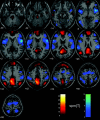Spontaneous low-frequency BOLD signal fluctuations: an fMRI investigation of the resting-state default mode of brain function hypothesis
- PMID: 15852468
- PMCID: PMC6871700
- DOI: 10.1002/hbm.20113
Spontaneous low-frequency BOLD signal fluctuations: an fMRI investigation of the resting-state default mode of brain function hypothesis
Abstract
Recent neuroimaging studies have lead to the proposal that rest is characterized by an organized, baseline level of activity, a default mode of brain function that is suspended during specific goal-oriented mental activity. Previous studies have shown that the primary function subserved by the default mode is that of an introspectively oriented, self-referential mode of mental activity. The default mode of brain function hypothesis is readdressed from the perspective of the presence of low-frequency blood oxygenation level-dependent (BOLD) functional magnetic resonance imaging (fMRI) signal changes (0.012-0.1 Hz) in the resting brain. The results show that the brain during rest is not tonically active in a single mode of brain function. Rather, the findings presented here suggest that the brain recurrently toggles between an introspectively oriented mode (default mode) and a state-of-mind that tentatively might be interpreted as an extrospectively oriented mode that involves a readiness and alertness to changes in the external and internal environment.
Figures






References
-
- Aguirre GK, Zarahn E, D'Esposito M (1998): The inferential impact of global signal covariates in functional neuroimaging analyses. Neuroimage 8: 302–306. - PubMed
-
- Andersen RA, Buneo CA (2003): Sensorimotor integration in posterior parietal cortex. Adv Neurology 93: 159–177. - PubMed
-
- Andersson JL, Hutton C, Ashburner J, Turner R, Friston K (2001): Modeling geometric deformations in EPI time series. Neuroimage 13: 903–915. - PubMed
-
- Andreasen NC, O'Leary DS, Cizadlo T, Arndt S, Rezai K, Watkins GL, Ponto LL, Hichwa RD (1995): Remembering the past: two facets of episodic memory explored with position emission tomography. Am J Psychiatry 152: 1576–1585. - PubMed
-
- Baker SC, Rogers RD, Owen AD, Frith CD, Dolan RJ, Frackowiak RSJ, Robbins TW (1996): Neural systems engaged by planning: a PET study of the Tower of London task. Neuropsychologia 6: 515–526. - PubMed
MeSH terms
LinkOut - more resources
Full Text Sources

